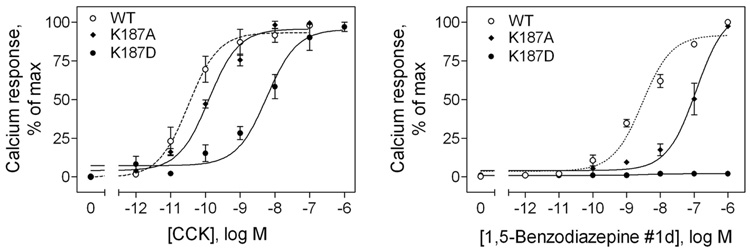FIGURE 3.
Effects of mutation of the CCK receptor residue Lys187 on biological activity of peptide and non-peptidyl ligands. Shown are intracellular calcium responses in CHO cells expressing the wild type, K187A, and K187D CCK receptor constructs to increasing concentrations of CCK (left) and non-peptidyl ligand, 1,5-benzodiazepine #1d (right). Data are presented as means ± S.E.M. of data from a minimum of three independent experiments. Basal level of intracellular calcium was similar for all the constructs (157 ± 26 nM), and maximal levels of stimulation by CCK reached 393 ± 33 (WT), 389 ± 47 (K187A) and 277 ± 33 (K187D) nM and by 1,5-benzodiazepine #1d reached 370 ± 29 (WT) and 355 ± 40 (K187A) nM. EC50 and Emax (delta change from basal) values are shown in Table 1. The CCK-stimulated intracellular calcium response was decreased about 4-fold by neutral charge K187A and 233-fold by reversed-charge K187D mutations. The 1,5-benzodiazepine #1d-stimulated calcium response was decreased about 20-fold by neutral charge K187A mutation, while the reversed-charge K187D substitution completely abolished the response.

